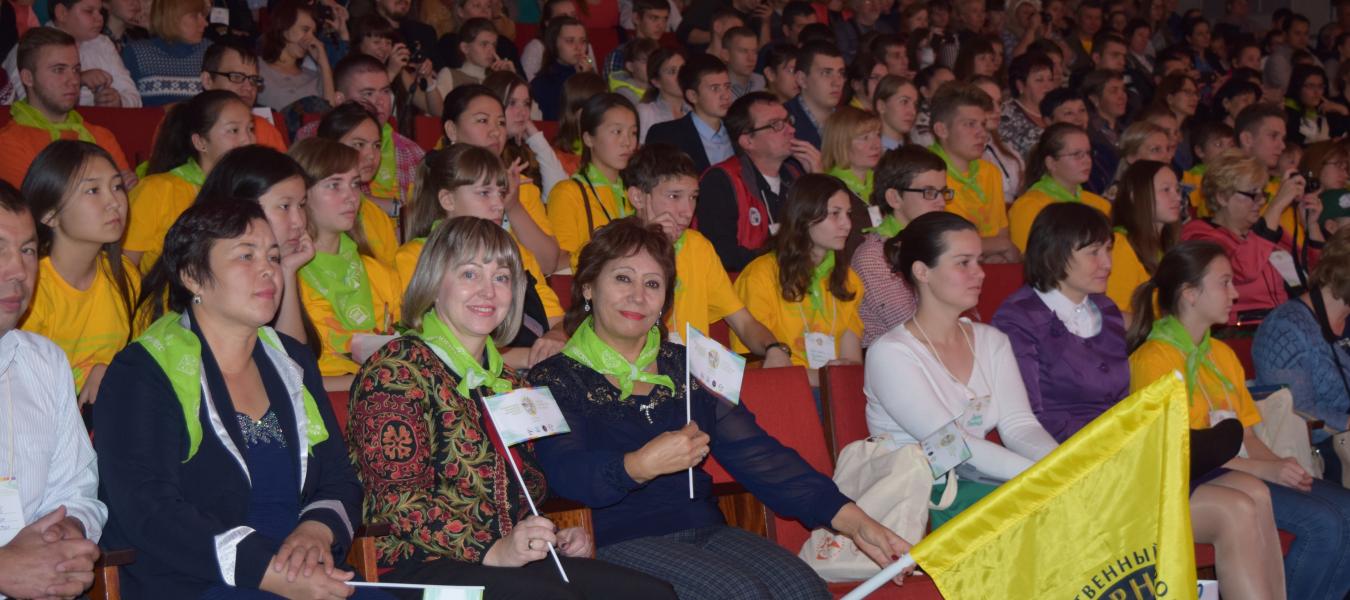"Friends of Conservation Islands" - a movement without borders
The “Friends of Conservation Islands” movement was an initiative of the EcoCentres of the Strict Nature Reserves (zapovedniks) in Russia, which started in 2000. Photograph shows participants from Uzbekistan and Kalmykia at the award ceremony for the best ecological project. Photo by Dzhirgala Oldvurova.
Update by Eugenia
Samtanova, Yashkul' Multidisciplinary Gymnasium School in
Republic of Kalmykia in Russia, and Natalya Shivaldova,
"Ekomaktab" Ecological Resource Centre in Uzbekistan. Published in
Saiga News
Issue 20, on page 12.
In the beginning it only united conservation enthusiasts within
Russia. This year the movement has stepped up to the international
level, thereby proving that nature does not recognize borders. The
International Youth Ecology Congress, "Friends of Conservation
Islands", dedicated to the upcoming 100th anniversary of Russia's
nature reserve system, was held in Voronezh on November 2nd-6th,
2015. Over 150 delegates (children, teachers, reserve staff, and
university and senior school students) took part, from 24 regions
of Russia and from Azerbaijan, Uzbekistan, Kazakhstan and
Belarus.
Steppe Wildlife Clubs at the International Youth Ecology
Congress:
The theme of saiga protection and conservation ran like a
scarlet thread through the congress. The Steppe Wildlife Clubs from
Kalmykia and Uzbekistan acted as a united team and successfully
presented their environmental protection projects. They held
various technical and creative master classes, captivated the
congress participants with the issue of saiga protection, and
shared their original approaches to outreach work with the general
public in saiga habitats.
The congress participants showed their concern about recent
deplorable events affecting saigas: the mass mortality caused by a
mystery disease in Kazakhstan; a border fence erected between
Kazakhstan and Uzbekistan; the steppe fires in Russia; and
continued poaching in all range states. A barrage of questions was
hurled at speakers from the Steppe Wildlife Clubs, which then
became a brainstorming session on ways to support the conservation
efforts of the Steppe Wildlife Clubs and the Saiga Conservation
Alliance. As a result of these discussions, the idea was put
forward to support the saiga conservation movement by holding
marathons in cities near saiga reserves in Russia, Uzbekistan,
Kazakhstan and Mongolia, and in China, Europe and America. The idea
was to hold the marathons simultaneously in different countries,
thus emphasizing that migratory animals do not recognize any
borders. This could attract the public's attention to the serious
threats encountered by all saiga populations. What do you think of
this idea? We suggest launching this initiative all over the
world!
The Friends of Conservation Islands Congress in detail:
The ceremonial opening of the Congress was vivid and memorable;
teams from various regions had prepared flags in advance with
images symbolising the conservation areas they represented. A team
form Kalmykia placed on their flag an image of a helpless lovely
baby saiga, the symbol of the Living Heritage Steppe Wildlife Club
and the Chernye Zemli Reserve. All the flags were then combined
into a single large flag, a patchwork of the Friends of
Conservation Islands movement, which solemnly sailed over all the
participants to the sound of guitars and the hymn "To Conservation
Islands" during the inauguration of the Congress.
The announcement of the results of the competition for
ecological projects carried out in 2013-15 by members of the
Friends of Conservation Islands movement was the most memorable and
exciting part of the congress. The creation of the Steppe Wildlife
Clubs network, under the guidance of Eugenia Samtanova in Russia
and Natalya Shivaldova in Uzbekistan, won the competition. The
winners were given diplomas and mini solar power stations.
Kalmykia was represented by members of the Living Heritage
Steppe Wildlife Club (Yashkul' school), Elzyat Mandjiyev and Tamara
Ubushayeva, as well as by the head of the Department for Ecological
Education and Tourism Information of the Chernye Zemli State Nature
Biosphere Reserve, Djirgala Oldvurova. The Uzbekistan team was
represented by the heads of two of the most effective Steppe
Wildlife Clubs; "Nadezhda" from high school № 37, Nukus city,
headed by Madina Abdikarimova, and "Akboken" from high school № 54,
Zhaslyk village, headed by Sadyrbai Shaimenov. The jury praised the
valuable efforts of the amateur ecologists and young people in
these countries. The main motto of the Steppe Wildlife Clubs is
"Prevent the loss of saiga, a unique component of wildlife".
A concert and folk discotheque was an emotional continuation of
the Congress. Every delegation showed all the colours of their
different cultures in their dances and songs. The attendees were
very interested in the Kalmyk dance called "Mingnbair", performed
by Elzyat and Tamara.
A tour of the Peskov State Nature Biosphere Reserve in Voronezh
was a vivid event for the Congress participants. Youngsters took
part in an ecological quest and a "Congress Trail". There were very
interesting and informative tours of the reserve and its museums.
The closing ceremony of this notable ecological forum will be best
remembered by ecologists; it summarised the outcomes of the
Congress and adopted a resolution about the main directions of
improvement for activities in Specially Protected Natural Areas in
years to come.
The delegations left the hospitable land of Voronezh full of
impressions and new ideas. We have truly become "friends of
conservation islands" and hope that the caring spirit of concern
for our land engendered by the Congress will not expire in the
souls of the new generation of young ecologists embarking upon the
noble path of nature protection.

